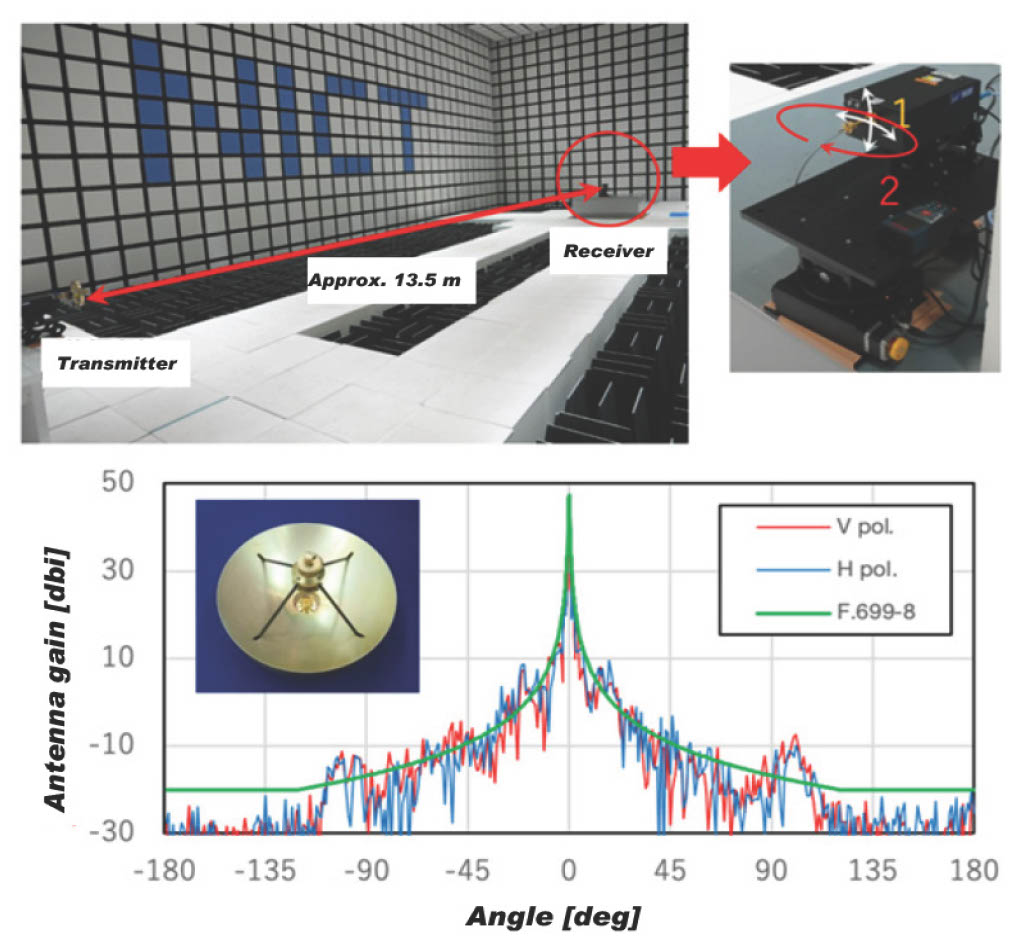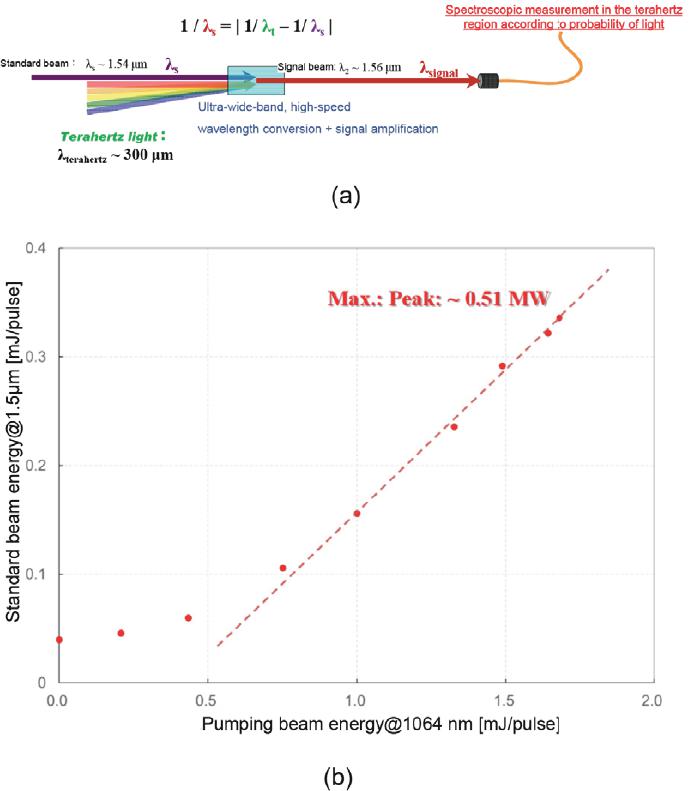Terahertz Laboratory (Frontier ICT Technology)
Terahertz Wireless Testbed Platform Technology
In FY2021, we developed characterization
technology for terahertz antennas with frequencies
exceeding 300 GHz with the aim of
establishing evaluation technology (Fig.1).
This system measures antenna radiation
patterns by separating the terahertz
transmitter and receiver by up to 13 m and
rotating the receiver antenna. We used this
system to measure the antenna radiation
patterns of a variety of antennas including
an offset parabolic antenna,
Cassegrain antenna,
and standard
gain horn antenna.
The results of these
measurements were
reflected in a contribution
to a draft report
on terahertz wireless
technology in the APT
Wireless Group (AWG)
under the Asia-Pacific
Telecommunity (APT),
an international standardization
organization in the Asia-Pacific region. Additionally,
with the aim of reducing the noise of terahertz
signals, we tested phase-noise compensation
technology using an injection-locked optoelectronic oscillator circuit
technique. This method reduces phase
noise by inputting millimeter waves and
terahertz signals generated by conventional
technology into an optoelectronic
oscillator circuit that can reduce phase
noise through a high Q factor and long
cavity based on an optical fiber loop. Inputting
a signal at a frequency of 102 GHz
resulted in a 5 dB improvement in singlesideband
phase noise at a frequency offset
of 2 kHz. Using this technology as a local
oscillation signal source in transmitters
and receivers is expected to achieve multilevel
modulation/demodulation technology
for multicarrier systems with narrow
frequency spacing.

and measured radiation patterns of Cassegrain
antenna (bottom)
Terahertz Spectrum Measurement Platform Technology
With the aim of achieving high-accuracy
spectrum measurements in the terahertz
region, we proposed a high-accuracy
terahertz wave generation, control, and
measurement technique traceable to a
national standard using bi-directional
wavelength conversion between infrared
and terahertz waves as an advanced platform
technology for generation, control,
and measurement. Figure 2(a) shows a
schematic diagram of spectroscopic measurement
of terahertz waves using wavelength conversion.
The spectrum of a wavelength-converted
infrared beam in nonlinear crystal reflects
the spectrum of the terahertz wave
to be measured. Accordingly, by using a
frequency stabilized and controlled infrared
beam as a traceable pumping, seeding
and signal beam, it becomes possible to
control or measure the spectra of terahertz
waves in a traceable manner as well. Here,
we used an amplified optical standard
beam fed by optical communication fiber
as a frequency stabilized pumping beam.
Figure 2(b) shows pumping beam
(1064 nm) energy dependence of frequency
standard beam (1.54 μm) energy. As the
energy of the pumping beam increases,
the energy of the standard beam likewise
increases monotonically. We observed a
maximum standard beam energy of about
0.34 mJ/pulse corresponding to peak
power of about 0.51 MW when the input
energy of the standard beam was about
40 μJ/pulse and the pumping energy was
about 1.7 mJ/pulse. This is about 108 higher
peak power compared to the initially delivered
standard beam, which is sufficient for
terahertz wave spectroscopic measurement
via wavelength conversion. We plan
to increase the energy of the standard
beam to achieve a broader measuring
range and higher sensitivity.

Fig.2: (a) Schematic diagram of spectroscopic measurement
of terahertz waves using wavelength
conversion, (b) pumping energy dependence of
frequency standard beam energy.
International Standardization Activities
Beyond 5G Research and Development Promotion Unit has been actively working on spectrum standardization in the frequency ranges above 275 GHz at ITU-R accomplishing the following results.
- At the 2021 WP1A meeting, NICT proposed that the working document be modified towards a draft revision of Report ITU-R SM.2352-0, which was carried forward to the next meeting as a preliminary draft revision of the Report.
- At the 2021 WP5A meeting, NICT contributed to updating the working document towards a new Report M.[252-296 GHZ.LMS.FS.COEXIST], and proposed that the working document document towards a draft revision of Report ITU-R M.2417-0 be elevated, which was carried forward to the next meeting as a preliminary draft revision of the Report.
- At the 2021 WP5C meeting, NICT proposed that the working document towards a draft revision of Report ITU-R F.2416-0 be elevated, which was carried forward to the next meeting as a preliminary draft revision of the Report. NICT also submitted a contribution to add additional antenna patterns to a draft revision of Recommendation ITU-R F.699-8 and contributed to extend the frequency range covered by Recommendation ITU-R F.699-8 up to 450 GHz.
- At the 2021 WP5D meeting, NICT submitted a contribution to add THz technology to the working document towards a draft new Report ITU-R M. [IMT.FUTURE TECHNOLOGY TRENDS OF TERRESTRIAL IMT SYSTEMS TOWARDS 2030 AND BEYOND].
- At the 2021 AWG meeting, NICT contributed to developing an APT Report on 252-296 GHz fixed systems and an APT Report on walk-through imaging systems.
- At the 2021 APG meeting, NICT introduced THz standardization trends under WRC-23 agenda item 10 and contributed to developing APT Preliminary Views.
Activities at Terahertz Systems Consortium and Elsewhere
Amid growing attention to wireless communications technology using terahertz waves, discussions were held several times on use cases envisioned for 6G at the THz-6G Working Group (THz-6G WG) (Chair: Iwao Hosako, Director of Terahertz Technology Research Center; Vice-chair: Professor Tetsuya Kawanishi, Waseda University) organized in FY2020 within the Terahertz Systems Consortium. The results were reported at a lecture titled "Activities toward Terahertz Wireless B5G/6G" held as a webinar on March 1, 2022. A business seminar was also held in October of the same year with the aim of uncovering new users of terahertz technology.